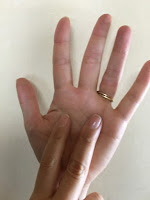 |
| Seven in Japanese... |
Regular snapshots of everyday life plus musings on Japanese culture and society for Japanese language learners and Japan lovers in general. Subscribe for email notifications when a new post goes up or send me a request (on the right panel). Comments are also welcome (link below each post).
Pages
▼
Tuesday, 9 May 2017
Counting, Numbers, and "Peace"
Numbers are very easy to learn in Japanese since 1-10 is pretty much all you need to know: 11, for example, is simply 10+1(jū-ichi = 十一) while 20, 30 etc. is just two 10's (ni-jū = 二十), three 10's (san-jū = 三十) and so on. After that, all that remains to learn are 100 (hyaku = 百), 1,000 (sen = 千), and also 10,000 (man = 万). The latter can be a little confusing since 50,000 would be 5 ten-thousands (go-man = 5万) never 50 thousands (go-jū sen?!?). There is no separate word for million - it is simply a hundred ten-thousands (hyaku-man). The existence of the 10,000 unit - there is also a ¥10,000 bank note - is such an ingrained way of conceiving numbers for the Japanese that even the advanced Japanese learner struggles with saying large numbers correctly in English.
Gestures used to express numbers are also interesting. Japanese start counting with the index finger, like the British and North Americans, not the thumb like Europeans. But they also have a novel way of counting to ten using one hand which begins with an open palm and then folding the thumb into the palm for one (see the video below). Finally, when signalling numbers from one to ten across a noisy area (like a market), the numbers 6 to 9 are shown by placing the fingers of one hand onto the palm of the other (the picture to the right is seven, for example). Incidentally, sticking up the index and middle fingers is not rude in Japan; indeed, it is a staple of photographs taken by young girls (especially JK or female high-school students) - see here for an example. The origins of this "peace-sign" are unclear and hotly disputed.